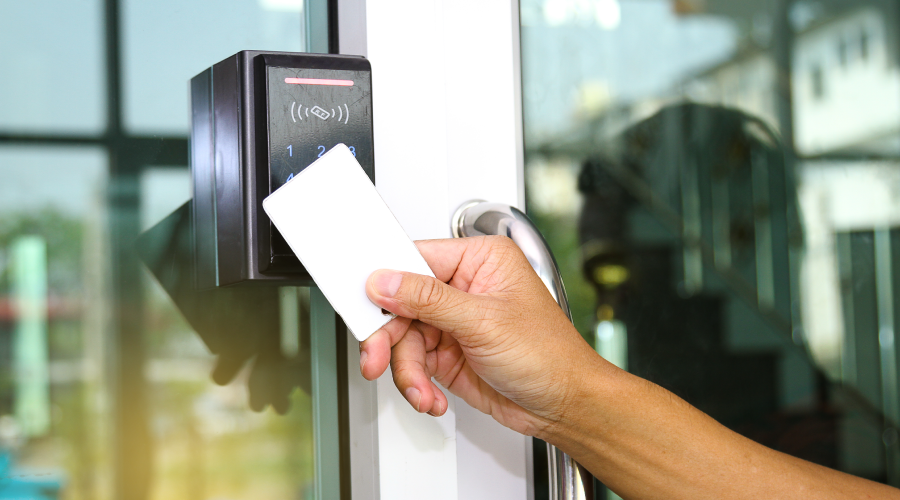Product Considerations for Door Hardware Upgrades
Security options for door hardware have advanced rapidly in recent years, due to increased demand from facilities. Manufacturers have responded with a range of new products to meet these evolving needs. Managers need to remember that door hardware products are only one part of the overall security program. They must work effectively with the existing security measures in the facility, including personnel, physical barriers, and procedures implemented.
Among the product options managers have are conventional key systems, mechanical keypad systems, self-contained or centrally monitored electronic keypad systems, self-contained or centrally monitored card-access systems, and self-contained or centrally monitored proximity readers. Each product has its own particular advantages and disadvantages.
A conventional key system remains the lowest-cost option for managers. On the upside, locks are easy to install or change, and security personnel can readily copy keys and issue them to the proper personnel. On the downside, occupants can lose keys or make unauthorized copies. Locks also can be easily picked or circumvented, particularly by experienced or determined individuals. Keys and locks are also subject to wear and vandalism.
Self-contained mechanical keypad lock systems are the least expensive option and often best suited for smaller facilities that do not have a large number of areas to protect or personnel entering those areas. Self-contained mechanical keypad locks require no keys, batteries or wiring. Combinations are easy to change as needed. They cannot, however, track a door's users.
Self-contained electronic keypads also do away with keys, but they require a power source, typically a self-contained battery. As with the mechanical keypad lock, it is easy to change combinations and most do not track users Centrally monitored electronic keypads require wiring to a central monitoring point, where managers can track users of a particular door, change lock combinations, change the door's operating hours, or even under certain conditions block out all users. Self-contained and centrally monitored keypad systems are suitable for use in numerous interior and exterior applications.
Self-contained card-access systems are widely used in applications such as hotels, where individuals need temporary or short-term access to a specific area. As with self-contained electronic keypads, internal batteries power these systems. They typically do not track users.
Centrally monitored card access systems allow the tracking of a door's use from a central location. Best suited for larger facilities with more than 200 users, these systems allow managers to readily give certain users access to specific areas of a facility. Managers can quickly delete a lost or stolen card from the system, and in an emergency, quickly lock down an entire facility or grant access to emergency personnel. Centrally monitored card access systems are used widely in internal and external applications.
Proximity readers function similarly to card access systems that do not require physical contact between the door's reader unit and a user's card or tag. With no contact between elements, wear and tear on the card and the reader decreases, and it reduces the chances of vandalism to the reader.
The latest generation of proximity readers uses radio-frequency identification technology. When a user holds the proximity card near the reader for a short period of time, the reader scans the card's identification number.
There are two types of proximity cards: passive and active. Passive cards are the most common type of card in use. Powered by radio signals transmitted from the reader, they transmit their encoded identification number to the reader. The most popular systems have a range of 12-15 inches, making them well suited for applications such as office buildings and parking garages.
Active proximity cards are powered by an internal battery and have a larger range than passive cards. Those operating on a frequency of 125 kilohertz have an operating range of up to 6 feet, making them suitable for the same applications as the passive cards. Those that operate on a higher frequency can have an operating range of up to 500 feet, making them suitable for use in moving vehicles, particularly in applications where gates or other barriers limit vehicle access. Typical battery life in active proximity cards is two-five years.
When planning and implementing a door security hardware upgrade, more is not always better. Managers need to balance the desire for an increased level of security with interfering in normal facility operations.
The key for successful implementation is flexibility. Facilities and their operations change, which in turn changes security needs. Whatever system is put in place must reflect those changes and must be able to do so quickly, with minimal disruption and at minimal cost. Determined individuals can breach even the best, most secure facilities. A manager's goal should be deterrence, not total protection.
James Piper, P.E., is a national consultant based in Bowie, Md. He has more than 25 years of experience with facilities maintenance, engineering and management issues.
Related Topics:













